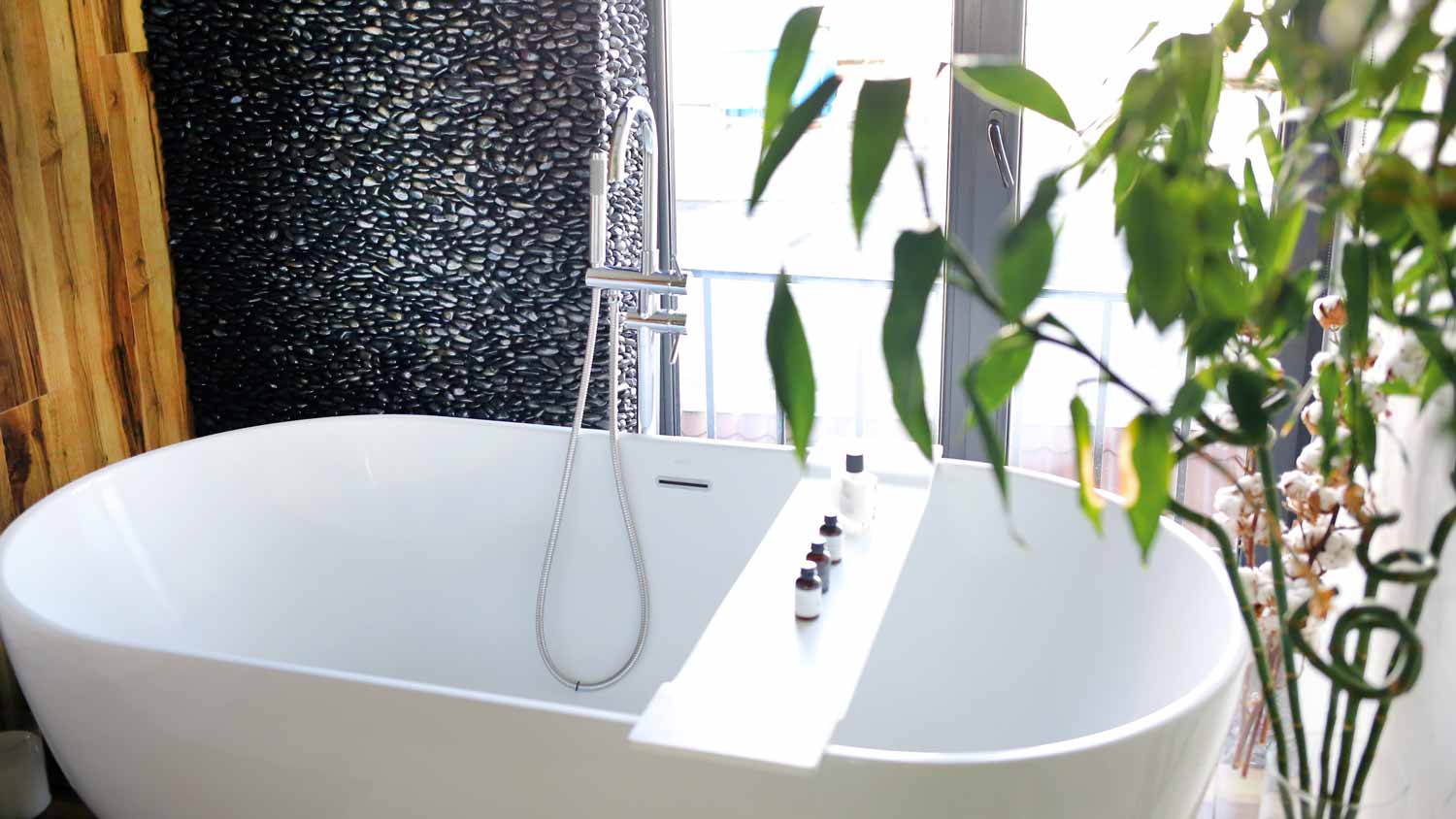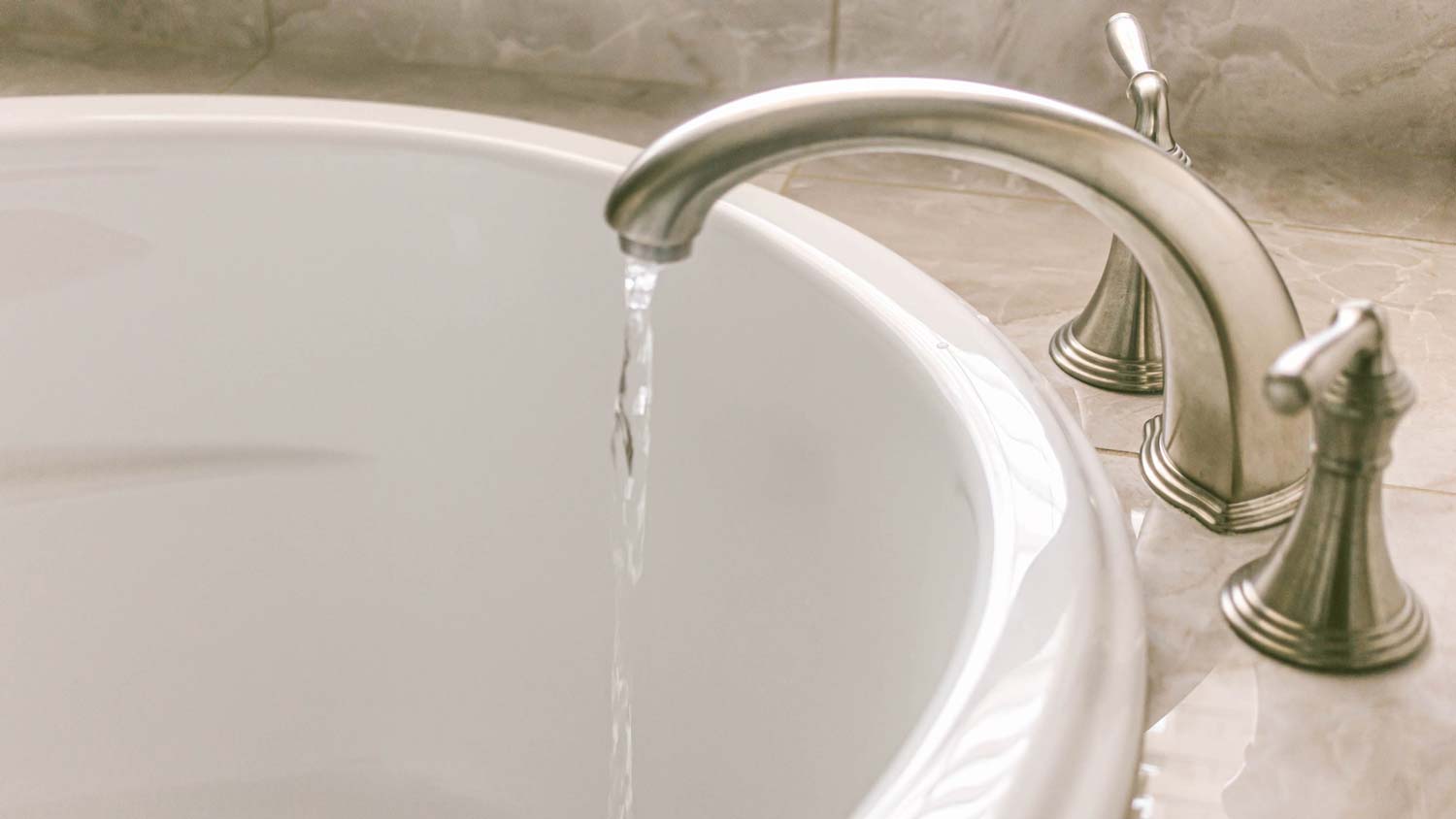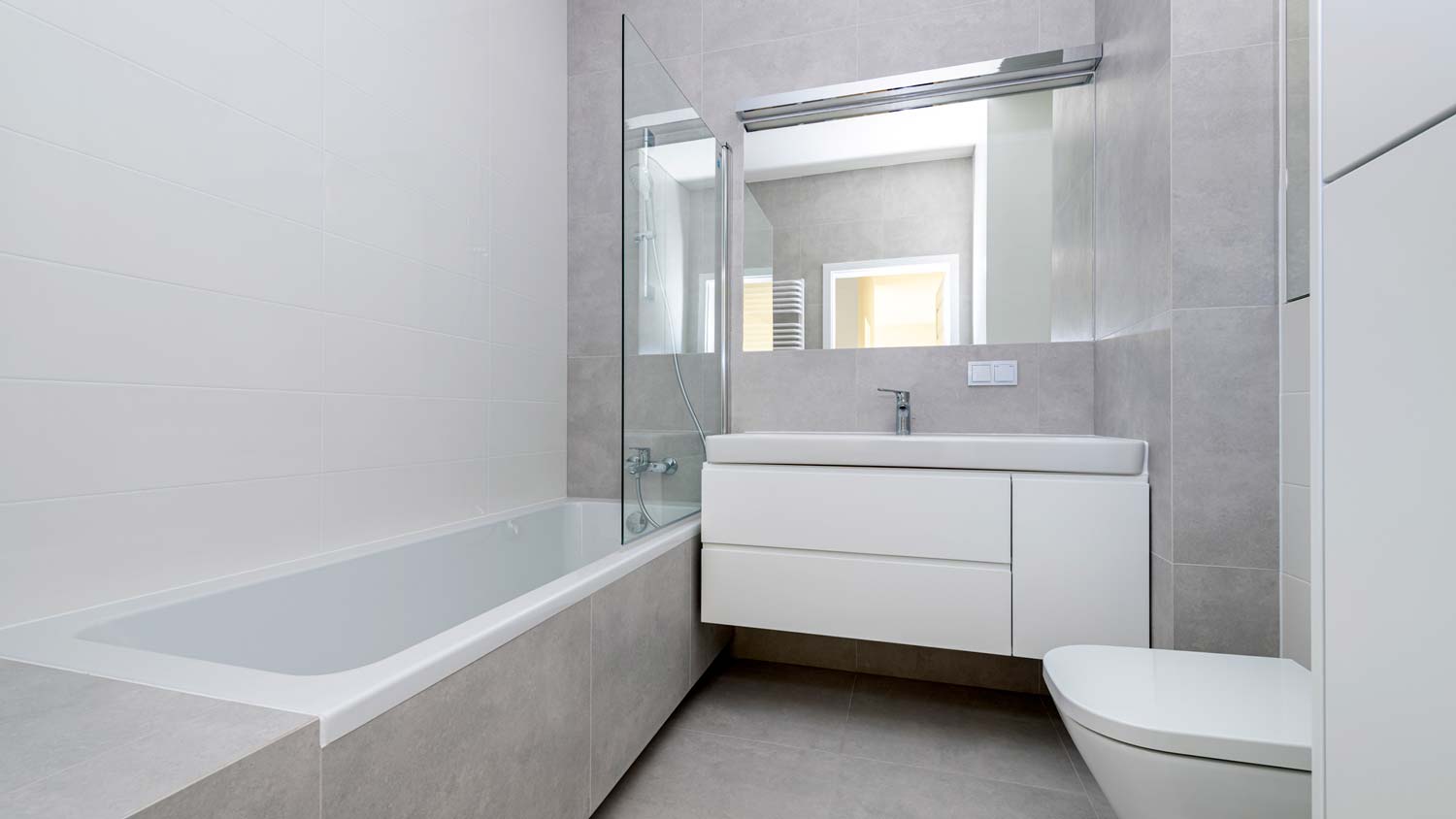Most Common Types of Bathtub Materials for Your Bathroom Remodel
Plastic and metal and porcelain bathtubs—oh my!


If a tub soak leaves you with a sore back and lukewarm water after 15 minutes, it’s time for an upgrade. Knowing the best bathtub materials will come in handy, whether you’re remodeling the entire bathroom or looking for a comfier tub.
Do you want your tub to hold in heat so the water stays warm? Do you want a sturdy tub or something lightweight for a second-floor bathroom? Here’s a comparison of seven types of bathtub materials to help you choose the perfect tub, including fiberglass, acrylic, cast iron, steel, porcelain, ceramic, and cast polymer.
What Are Bathtubs Made Of?
Various materials make up different types of bathtubs, from metals to porcelain to plastic like fiberglass or acrylic. Tubs can even be made with a combination of materials to give you a lightweight tub that holds heat like a cast-iron tub.
Most tubs today are made with fiberglass, acrylic, cast iron, steel, or porcelain, but you can find bathtubs made from stone, copper, or wood. Ultimately, the best bathtub material will depend on your bathroom’s location in the house, budget, and style preferences.
1. Fiberglass

If you’re looking to keep the cost of a new bathtub on the lower end, plastic options like fiberglass are budget-friendly. Fiberglass tubs cost around $200 to $800 and consist of layers of reinforced plastic coated with resin. This material is lightweight, making it easier to install and great for bathrooms on any level of the house.
There are some drawbacks to fiberglass tubs, though. Fiberglass is a porous material, causing it to absorb water and crack over time. Over time, commercial bathtub cleaners can wear down fiberglass, as this material is vulnerable to scratching and warping. Fiberglass tubs will also fade or experience discoloration with time.
| Pros | Cons |
|---|---|
| Budget-friendly | Absorbs water |
| Lightweight | Can develop cracks |
| Simple installation | Fade or discolor over time |
Best for: Homeowners seeking a cost-effective bathtub installation
2. Acrylic

Acrylic tubs, which weigh around 75 to 110 pounds, are another lightweight option. Expect to pay about $700 to $1,000 for an acrylic tub. Manufacturers create acrylic tubs with stabilizers, fillers, resins, and other chemicals and reinforce them with fiberglass—making for a nonporous tub material that’s durable against discoloration and general wear and tear. Its durability makes acrylic one of the best materials for freestanding tubs.
While acrylic tubs are great at retaining warm water temperature and are slightly more resistant to scratching than fiberglass tubs, they tend to flex and move and can warp over time. Like fiberglass, avoid cleaning acrylic with abrasive cleaners and tools, which leave scratches.
| Pros | Cons |
|---|---|
| Resists discoloration | Can warp over time |
| Durable | Flex and move |
| Lightweight | Susceptible to scratches from abrasive cleaners |
Best for: Creating relaxing freestanding bathtub setups
3. Cast Iron

For durability and longevity, cast iron is the way to go. Cast-iron tubs are made by pouring hot, molten iron into a bathtub mold and covering the tub in enamel. Like your favorite cast-iron skillet, cast-iron tubs retain heat well and are easy to clean. As a bonus, this material is highly resistant to chips and scratches.
There’s a lot to love about cast iron, but this long-lasting material will make your tub more expensive and difficult to install. These tubs cost an average of $1,300 and weigh around 350 to 500 pounds. While looking for pros who install bathtubs, you may need to budget for additional floor reinforcements to handle the weight of a cast-iron tub. Hire a bathtub installer near you who can get the job done safely and efficiently.
| Pros | Cons |
|---|---|
| Durable with a long life span | Higher cost |
| Easy to clean | Complex installation |
| Retains heat | Might require floor reinforcements to support the weight |
Best for: A long-lasting installation (70 years or more)
4. Steel

Many bathtubs today are made with enameled steel, which is manufactured from steel sheeting coated with porcelain. This combination makes for an inexpensive tub ranging from $200 to $1,000. Enameled steel is lighter than a cast-iron tub but weighs about twice as much as plastic-based bathtubs.
Enameled steel is inexpensive, but this material is vulnerable to chipping. Steel tubs also transfer heat quickly, meaning your hot bath water will cool off quickly. If long soaks are a priority, consider whether steel is the best tub choice for you.
| Pros | Cons |
|---|---|
| Cost-effective | Susceptible to chipping |
| Weighs less than cast iron | Hot water heat transfers quickly |
| Resistant to bacteria and mold | Extra weight makes the installation more challenging |
Best for: A mid-range option between plastic and cast-iron tubs
5. Porcelain

The cost of a porcelain tub ranges from $200 to over $2,000. Porcelain tubs consist of a layer of porcelain over a cast-iron or steel base, or less commonly, glass or tile.
Cast iron is better for keeping bath water warm for longer, while steel is lighter in weight. Enameled cast iron is more durable than porcelain-coated steel tubs. No matter the base, porcelain can be vulnerable to chips, so avoid dropping heavy items on a porcelain tub.
| Pros | Cons |
|---|---|
| Easy to clean | Vulnerable to chipping |
| Holds up to scratches | Limited designs |
| Long-lasting with proper care | Less heat retention |
Best for: A low-maintenance tub that looks beautiful
6. Ceramic

If a beautiful tub that boosts your bathroom's look is important to you, ceramic tile tubs offer a huge range of designs to choose from. But with these more unique choices, you can expect to spend $5,000 to $10,000 for a ceramic tub. These tubs require extra care during installation, and you’ll need to keep up on maintaining and fixing the grout between ceramic tiles.
| Pros | Cons |
|---|---|
| Wide range of design options | Needs cleaning and maintenance for grout |
| Higher cost | Tile installation requires more care |
| Easy to clean | The porous surface isn’t waterproof |
Best for: Creating custom bathtub designs in different styles and colors
7. Cast Polymer

Cast-polymer bathtubs are made with engineered natural stone and solid surface material, such as resin, to mimic the look of marble, onyx, or granite. These stylish bathtubs cost around $2,000 to $5,000. Aside from a chic look, these tubs are also easy to clean and resistant to mildew.
While you can buff out minor scratches in cast-polymer tubs, their coatings can wear down over time. When this happens, the tub becomes brittle and vulnerable to cracks.
| Pros | Cons |
|---|---|
| Mimics other materials like granite or marble | Coats wear down over time |
| Resistant to mildew | Susceptible to cracks |
| Easy to maintain | Can discolor without proper care |
Best for: Getting the look of materials like marble or onyx
What to Consider When Choosing a Bathtub Material
The following factors will determine the right bathtub material for your home.
Weight
Don’t overlook this factor when switching from an acrylic or fiberglass tub to a heavy cast-iron or composite stone model. When upping the weight class of your bathing experience, you might need to reinforce your floor. Budget to inspect for—or install—the requisite floor joists to accommodate the weight of your new tub.
Cost
Bathtubs can cost anywhere from $200 to $10,000, so your budget may decide your tub material. The most expensive tubs are ceramic or stone, while the least expensive are acrylic or fiberglass. Porcelain, cast-iron, steel, and cast-polymer tubs fall toward the middle of the cost range. Don’t forget the cost of installing your new bathtub—heavier pieces cost more in labor, too.
Durability
Cast-iron tubs are the most durable, but porcelain and ceramic tubs are next in line. Cast-polymer, metal, fiberglass, and acrylic tubs need more care and can be scratched or chipped more easily. Most tubs made from natural materials can stain from rust or mineral deposits in your water. Keep that in mind when choosing a material to last.
Heat Retention
Cast-iron tubs are best for heat retention, while materials like acrylic and fiberglass might allow bath water to cool more quickly. If you prefer a good, long soak in the tub, go for cast iron or porcelain.
Maintenance
Cleaning is the most common maintenance you’ll need to do for your new tub. Tubs with a more durable surface, like cast iron and porcelain, will be easier to clean, and with fewer grout lines, crevices, and seams, they will be easier to clean day-to-day. Acrylic and fiberglass options are simple to clean but can become discolored over time.
Installation
Installing a new tub is simpler when there are fewer pieces, and installation can be more complicated if your tub needs a tile surround. Moving taps and drains means hiring a local plumber rather than a handyperson to install the new fixture, so choosing a tub similar to your current fixture can reduce costs.
Frequently Asked Questions
While they’re heavier than their counterparts, cast-iron tubs are very simple to maintain. They have no seams and are durable, making them the easiest tub to maintain. While fiberglass and acrylic tubs are also relatively simple to maintain, they often have seams, making maintenance a little more difficult.
Cast iron and copper are the two most durable materials for a tub because they're dense and resistant to damage from scratches or dents. However, copper needs to be chemically treated regularly to prevent a patina from forming, so cast-iron tubs are less maintenance-intensive. Porcelain is a good second option.
If your tub is attached to the wall, the best material will be one that can be shaped to fit your space perfectly. A cast-polymer, acrylic, or fiberglass tub will likely be the easiest to install as a built-in because it can be designed to fit your space.





- Bathroom Remodeling
- Kitchen Remodeling
- Shower Installation
- Stair Installers
- Bathtub Installation
- Shower Door Installers
- Kitchen Design
- Bathroom Design Companies
- Storm Shelter Builders
- Pre-Made Cabinets
- Kitchen Refacing
- Bathtub Replacement
- Ceiling Tile Installation
- Suspended Ceiling Companies
- Residential Designers
- Stair Builders
- Remodel Designers
- Shower Enclosures
- Home Renovations
- Kitchen Renovations
- Garage Remodeling
- Grab Bar Installation
- Walk-In Tub Installers
- Tub to Shower Conversion
- Balcony Contractors
- Acrylic vs. Cast Iron Tub: Which Is the Right Option for Your Bathroom?
- Acrylic vs. Porcelain Tub: Which Is the Best Option for You?
- 6 Tips to Choose the Best Bathtub for You
- Acrylic vs. Fiberglass Bathtubs: How They Compare and Which Is Best for You
- Standard Bathtub Sizes: How to Choose the Best Size for Your Bathroom
- How to Remove a Bathtub for a Bathroom Renovation
- What Is a Soaking Tub? Everything You Should Know
- Pros and Cons of Walk-In Bathtubs: Are They Worth It?
- Jetted Tub vs. Hot Tub: What Is the Difference?
- Parts of a Bathtub: 10 Key Components














